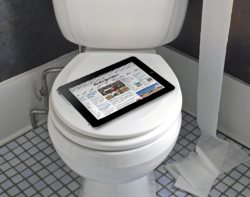The Age of Bathroom Computing Has Arrived. Should You Give a Crap?
I was talking to an IT manager friend about smart phones the other day and was surprised to hear that she didn't want one. “I work from home and don't leave the house enough to need one,” she said. “Do you go to the bathroom?” I asked.
My friend doesn't realize it, but we've recently entered a new phase of highly-connected computing. In the 80s, PCs allowed users to bring the computing experience home from the office. In the 90s, widespread access to the Internet allowed users to stay connected from home, albeit usually from a single table or desk in the home. In the first decade of the 21st century, affordable notebooks and netbooks allowed users to take the Internet experience around the house or take it on the road.
So where is computing headed in the 2010s? Straight into the toilet! Or at least near it. Our lives are so connected these days that it's not enough to be online only when you're at your desk or sitting upright on the couch. Sure, you can use a laptop when you're lying in bed, sprawled out on the couch, or stationed on the throne. But the clamshell design of a laptop becomes nearly impossible to use when you're flat on your back. Plus, the idea of putting a computer on your lap while you perform certain bodily functions is just plain gross.
Enter slate devices like smart phones and tablets. You can easily hold a touchscreen phone or tablet aloft while you lie in bed, curl up on the couch, or work through your digestive process in the restroom. You can curl up with a good book, movie, or site when you have a slate device. You can even use them when you're standing in line or walking down the street. Try that with your notebook or netbook.
Despite the faster booting and resume from sleep times we've seen in Windows 7 and Snow Leopard, notebooks also make poor always-on devices. If you're sitting on the couch watching a movie and want to know if you've received any important e-mail messages, you need to pop open your notebook, wait for it to power on and connect to Wi-Fi, and then log into e-mail, just to see if you've gotten anything important. Resuming from sleep can also take a while, depending on the laptop.
With a tablet or smart phone you can catch up on your Twitter feed and e-mail anytime, as well as check your favorite sites or watch the last bit of Lost you forgot to DVR. And that constant connectivity (plus plenty of fiber) gives us the freedom to visit the restroom, knowing that we won't miss anything while we're in there.
The iPad might not be ideal for editing documents or cropping photos, but it just might be the ultimate potty PC. Its large screen makes consuming content easy and it's lightweight enough that you can hold it above your lap for as long as it takes for you to deal with No. 2. Smart phones like the Motorola Droid, Nexus One, and iPhone are also great for water closet web surfing. Though they have smaller screens than a 10-inch tablet, they make up for that with lighter weights and mobile broadband connectivity that works even when you're using – heaven forbid – a public restroom.
Sign up to receive The Snapshot, a free special dispatch from Laptop Mag, in your inbox.
Now that we're bringing the Internet into the bathroom with us, we're left with another question: where will computing go next? For that we have just one answer: the shower!


